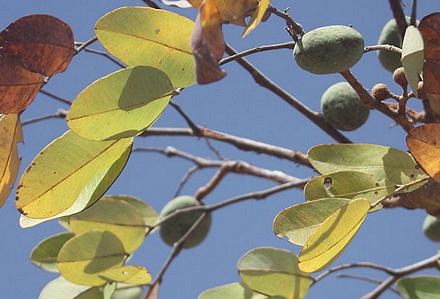 [Sweet Detar, Sweet Dattock; Ofor (Nigeria (ground seeds));
Ntamajalan (Bambara); Dankh, Petit Détar (French);
Abu-laili (Sudan); Tamba Dala (Mali); Detarium microcarpum |
Detarium senegalense | Detarium macrocarpum
all of Family Fabaceae (Beans)]
[Sweet Detar, Sweet Dattock; Ofor (Nigeria (ground seeds));
Ntamajalan (Bambara); Dankh, Petit Détar (French);
Abu-laili (Sudan); Tamba Dala (Mali); Detarium microcarpum |
Detarium senegalense | Detarium macrocarpum
all of Family Fabaceae (Beans)]
These medium to large Trees are of very similar characteristics, have very
similar uses, and share local names:
Detarium microcarpum grows to 62 feet (19 meters) in the dry savanna
band from Senegal in West Africa to South Sudan in East Africa.
Detarium senegalense grows to 131 feet (40 meters in the dry
forest band from Senegal to Nigeria. Fruit of some trees is toxic, and the
only way to tell is that fallen fruit under a toxic tree will not be eaten by
birds or animals.
Detarium macrocarpum grows to 196 feet (60 meters) in the moist
forest band within Nigeria, Cameroon, and Gabon. Fruits are about 1-1/2 inches
long (4 cm) and 1 inch (2.5 cm) diameter.
Photo by Marco Schmidt distributed under license
Creative Commons
Attribution-Share Alike 3.0 Unported.
The Fruit can be eaten raw or cooked, but the fruit pulp is more commonly dried and ground to a flour, though it is also suitable for concentrate and jam. Fruit can be stored for years, because the sweet pulp is dry and fibrous, similar to the related Tamarind.
Seeds are very popular hulled, shelled, and ground for use as a thickener and flavoring in soups and stews, or the kernels can be added whole as a vegetable. The ground form is called Ofor in Nigeria, and very popular there, particularly for Oha Soup.
Leaves are used as green vegetables, and Flowers are used condiments.
More on Beans, Peas and Lentils.